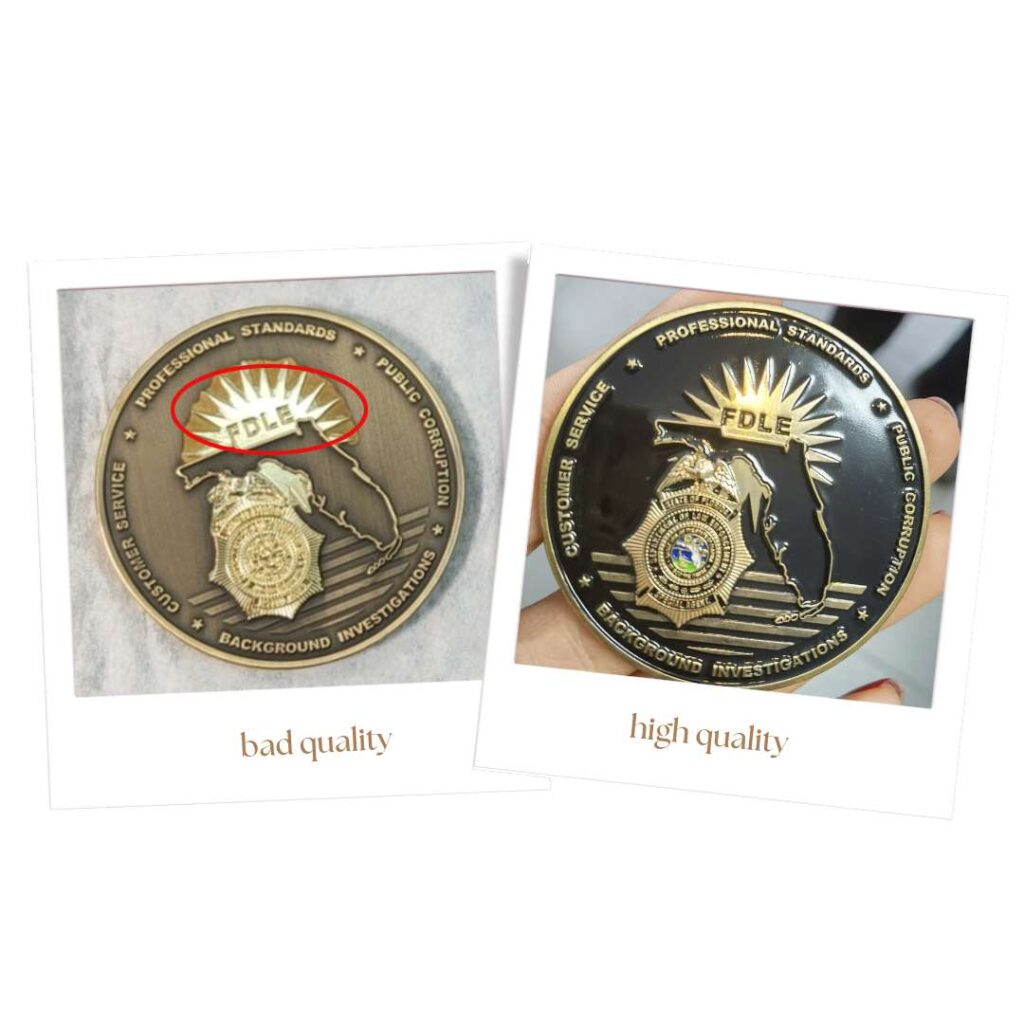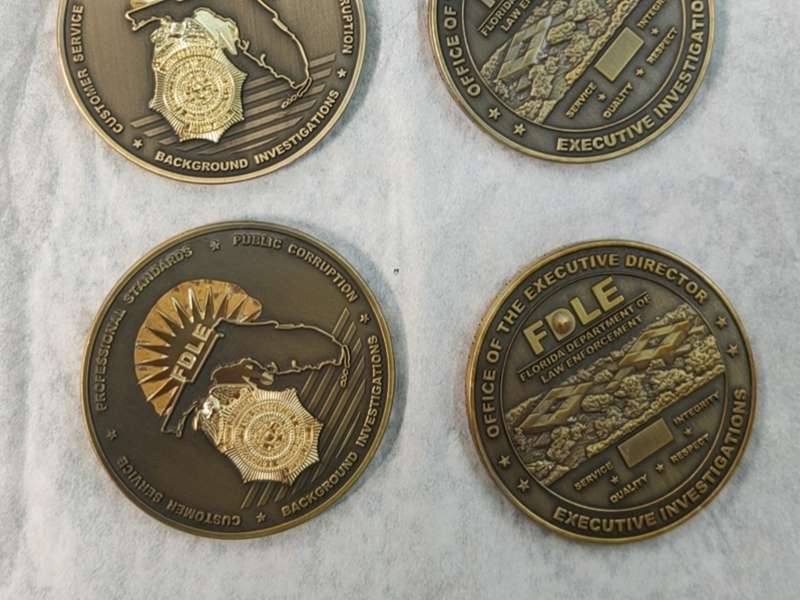Challenge coins are a type of coin, badge, or token that can be used as a military or school symbol of recognition.
Acquainting yourself with what goes on inside the factory is important. Understanding the production process of challenge coins will help designers to bring their ideas to life.

Let’s get ready to explore the captivating world of coin factories. Even though it won’t have any chocolate rivers or lollipop forests, it is a fascinating place. Rest assured knowing that your children will be safe from anything like getting turned into giant blueberries.
In this guide, we will explore the necessary steps to create custom challenge coins from the artwork.
The process of making challenge coins
The process of creating challenge coins involves a series of steps from design to production. It begins with the concept and design phase and then moves into the production phase where the coin is cast, cut, enameled, plated, and finally finished.
Later steps involve quality control, packaging, and shipment. In each step, a separate process is used to create an unforgettable item. Below are the details.

Step 1. Provide a design and get the quote
If you have a designer, send us the artwork in AI, PDF or EPS. But files like jpg, jpeg, and png are also accepted.
Our team could render digital designs into production-ready vector files, while some manufacturers couldn’t provide the service for transformation.

While designing custom coins, it is essential to take into account the production minimums and tolerances that are required.
We often receive artwork files from artists that are not in a suitable scale for producing coins. Simply shrinking the size of the artwork may not be enough, as it needs to be drawn to scale right from the start.
Keep in mind Blythe offers free artwork revisions and will price match guarantee the lowest price on your coins.
After sending the size, quantity, material, and gold plating, you will get the quote. All custom quotes are free.
Step 2. Confirm the mock-up design
A professional designer will begin your custom mock-up design. The design includes size, craft details, and color numbers on the Pantone matching system.

After customers confirm and make payment, the CAD drawing will begin then CNC machines will automate the cutting metal process according to the design. The computer can understand what you were doing.
Step 3. Make samples (Optional)
Pre-production samples and photos allow buyers to see what they are ordering before the product is manufactured, reducing costly mistakes and ensuring that the product meets the buyer’s expectations.
a. Make samples and take photos to confirm
After the sample is made, the factory can take photos to confirm before getting into full production.
This should be detailed showing the size, color, texture, etc., to ensure that buyers get exactly what they ordered without any surprises once the product is received.
b. Send the real sample to confirm
Or the factory will send the sample to the customer’s address when the coins are ready.
Step 4. Arrange mass production of the coin
The mass production of coins is a complex process that requires careful planning and execution. By leveraging the latest technologies such as automation, artificial intelligence, and advanced manufacturing processes, mass production of coins can be achieved efficiently and cost-effectively. This allows for quick turnaround times and large orders to be fulfilled with ease.
Step 5. Create the mold set
CNC machines are incredibly powerful to cut metal into pieces. To do this they use a negative copy of your design and carve it into a large die or mold.

This method ‘trims’ your design to create a precise copy of it on another metal surface.
Crafting coins requires two molds, one for the obverse and another for the reverse. These castings are typically crafted from resilient metals like steel, which provide great strength and durability to prevent bending or deforming your design under pressure.
An efficient production line can be completed with just one mold set, regardless of the number of coins you request.
Step 6. Temper the mold in a hot oven
By preheating your oven to the correct temperature, you can ensure that your mold will be tempered correctly so you can produce quality results each and every time.
By hardening the steel, its durability is increased, allowing it to withstand the strong pressure from die-striking brass coins.

After heating the molds to an optimal temperature in the oven, we submerge them in cool oil.
It requires between 500 to 1,000 tons of power to imprint a design on brass and by pre-heating the coin molds, they become strong enough to be able to carry out the procedure.
Step 7. Use the coin press to stamp
Die striking utilizes coin molds to press artwork into brass. This process creates a personalized impression on the metal.
Coins typically range from 1.5” to 2” in diameter when completed, and these are the sizes we usually stick to for our challenge coins.

Nevertheless, not all coins are struck using pre-made coin blanks. For specially designed shaped coins, the process is a bit different.
Instead of manufacturing individual round coin blanks, we are now using a die-striking process that stamps the design on a single brass strip multiple times. We then cut those out after it’s finished.
This is proving to be much more efficient than the traditional coin press technique.
Producing custom coins requires a custom cutter, which is why we use Wire EDM technology to manufacture them. The process works for both traditional round coins and complicated shapes alike.
Prior to being used, the cutting molds need to be carefully trimmed and heat-treated. After that, they are loaded into a specialized coin press which will cut the coins out of brass strips featuring the desired artwork.
Step 8. Cut out the edge and Debur
Creating the perfect piece of metalwork is no easy feat. Coins have sharp edges and ridges created by stamping.
To handle them safely, we need to deburr them first which smoothens any sharp edges on them.

This is important as it can be risky to handle the coins without gloves at this stage. Some edges may require manual cutting.
Deburring is a process that can be done in different ways. Coins may be put in machines with water, soap, and porous stone to help wear off rough edges as the machine spins.
Alternatively, coins might also be placed in dry media and rolled around to polish their surfaces.
Step 9: Metal Plating and Color filling
Metal plating involves electroplating a thin layer of metal onto the surface of the coin to create a protective barrier, while color filling involves filling in the recessed areas with colored enamel paints, giving your coins a unique and vibrant look.

With these two processes, you can create coins that will stand out from others on the market.
The production process for soft enamel coins begins with metal plating, followed by color filling. On the contrary, hard enamel coins go through color filling first before they are metal plated.
The metal molecules are attracted only to materials that conduct electricity, leaving the enamel paint unchanged and its original color unaltered.
A. Metal plating
Coins go through a thorough cleaning process before they are plated. First, they are soaked in clean water, followed by different chemical solutions to wipe off any dirt. This ensures that the coins get an even layer of the coating when plated.
Metal plating is the process of coating coins with precious metal to make them look more attractive. It involves immersing the coins in a specially prepared solution that contains the desired metal.
Most coins are usually plated in gold, silver, or copper. However, we also offer the option of creating coins with black nickel coating or giving them a rainbow-like metal finish.
Regardless of the details, an electrical current is passed through the solution that contains coins and other valuable metals. This generates a reaction that separates out the desired precious element.
The coins, attached to the copper wire, draw in precious metal to create a thin and permanent coating of custom metal plating.
B. Soft Enamel coins
Once the coins are cleared and dried, they enter the color-filling room. This process is usually done manually, but we also have machines that can do it automatically and quickly.
The recessed areas of our designs are carefully adorned with soft enamel paint using specialized syringes by our production staff.
After adding all the hues, we place the coins in an oven to solidify the enamel finish.
C. Hard Enamel Coins
Hard enamel coins require a process where the recessed areas are filled with specialized enamel paint. These coins are then put in an oven for the paint to achieve its cured state.
The coins are given color by going through this process multiple times. After they have all been colored, they are manually polished to give them a high level of shine.
The polishing process is done to give coins a crisp, even feel and look. It does this by removing the extra enamel paint from the surface.
Step 10. Screen print the details or add velvet craft
Screen printing is a popular option to add another level of detail to hard enamel pins.
It is a process of using ink to add extra details to a finalized design. It enhances the look and feel of the product, making it more desirable.
And Velet craft is a unique and intricate way to add an extra layer of detail and beauty to challenge coins.

The process involves adding fine details to the surface of the coin, such as engraving or etching, which can create a stunning visual effect.
If adding the resin on the coin for production, the velvet effect is added before metal plating.
Step 11. Laser Engraving
Laser engraving can be used to personalize items with names or sequential numbers.
Laser engraving is a great way to achieve finer details that would otherwise be impossible to achieve with die striking.

This process is perfect for creating custom gifts, promotional items, or awards as it allows for precise and detailed customization.
Step 12. Quality inspection and packaging
Every individual pin is thoroughly checked with a manual inspection three times to make sure you receive the best possible quality.

And the packaging is going to be a customer’s first tactile experience.
Before shipping, Blythe will wrap each pin in a bubble for added protection to avoid getting squashed or folded in transit.
On the rare occasions when coins do not meet our quality standards, we set them aside, and create new ones to fulfill the order.
Step 13. Prepared for shipping
Once a product has been inspected and approved, it’s time to get it ready for shipment.

This involves taking the necessary steps to ensure that the product is safely packaged, labeled correctly, and shipped on time.
By keeping detailed records of this process, businesses can guarantee that their products will arrive in perfect condition and on schedule every time.
We will confirm the address before shipping and the coins will be delivered via UPS or FedEx priority air shipping in about two weeks leaving our production team in the USA.
How to Choose a coin factory?
Although many designers selling coins online argue that working with an enamel pin factory in China is the best option, our experience has revealed this doesn’t always prove to be true.

Blythe has specialized in crafting high-quality custom coins. Our team is highly experienced and knowledgeable when it comes to the challenging coin production process.
We offer a 100% quality guarantee, money-back guarantee, upfront price with no hidden fees, and faster shipping that distinguishes us from the competition.
We give you the flexibility to revise your design as many times as required without any extra costs.
If you’re unsure of how you want your coins to look, Blythe Trading Co., Ltd has plenty of stock designs available in their inventory.
Order your exclusive military challenge coins today!
We appreciate you taking the time to go through our content and we value your service. We are eager to gain your trust and do business with you in the near future.

External reading: 1. Types of Challenge Coins
Custom Military Challenge Coins
Custom military challenge coins are a unique way to recognize and reward members of the armed forces for their service.
With a wide range of designs and materials available, custom military challenge coins can be tailored to fit any branch or unit of the military and are a great way to show appreciation for those who serve our country.
From metallic alloy coins to enamel-painted coins, there is something for everyone when it comes to custom military challenge coins.
US Army Military Challenge Coins
Military challenge coins have been used by the US Army for centuries to recognize outstanding service and achievements. They are a symbol of unity, pride, and honor among members of the military. These coins are usually given to soldiers as a token of appreciation for their service and as a reminder of their commitment to duty.
The US Army has used challenge coins in various forms since World War I, with its first official coin being issued in 1973. Each coin is unique, with its own design that reflects the unit or individual it was issued to.
Military challenge coins are a great way for soldiers to show their commitment and loyalty to their country and fellow servicemen.
Marine Military Challenge Coins or USMC Challenge Coins
Marine Military Challenge Coins, also known as USMC Challenge Coins, are coins that have been used by the United States Marine Corps (USMC) since World War I.
These coins are a symbol of camaraderie and pride among the Marines. They are also a reminder of the commitment and courage of those who serve in the Marine Corps.
They are not only a symbol of military service but also a reminder of all that is expected from those who serve in this branch of the military.
Air Force Challenge Coins or USAF Challenge Coins
Air Force Challenge Coins, or USAF Challenge Coins, are an important part of the United States Air Force culture.
These coins are used to recognize and honor those who have served in the Air Force and have made a significant contribution to their unit or mission.
They are often given as a memento of appreciation for their service and dedication. The coins come in different sizes and designs, each with its own unique meaning and symbolism.
They are an important part of the Air Force tradition, representing loyalty, camaraderie, bravery, excellence, and pride.
Navy Military Challenge Coins – US Navy Challenge Coin
Navy Military Challenge Coins are a unique and meaningful way to recognize and honor the service of US Navy personnel.
These coins are a symbol of pride and dedication, used to recognize the hard work and bravery of those who have served in the Navy. They come in a variety of shapes, sizes, colors, and designs, making them an ideal way to commemorate any special occasion or event.
With their unique design elements and intricate details, these coins make for a truly one-of-a-kind memento that will be cherished for years to come.
Challenge Coins FAQs
What is a Challenge Coin?
A challenge coin is a specially designed coin given to confirm membership in an organization or group. It’s typically small in size, bearing an organization’s logo or emblem and carried by all of the organization’s members.
When you use the custom challenge coin
Custom challenge coins have become increasingly popular in recent years as a creative way to commemorate events and recognize individuals in unique ways.
These coins are versatile and can be used for a variety of purposes, from honoring military service to thanking customers or employees for their hard work.
They also make great gifts and tokens of appreciation that can be cherished for years to come.
What metal are Challenge Coins made of?
Challenge Coins are generally made of metal, such as bronze, brass, silver, or gold.



